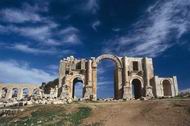
Sint-Simeonklooster
Aleppo Citadel stands on a 50 metre high hill and habitation on its top is thought to date back to the 16th century BC although the earliest remains found so far are Roman and Byzantine from the 9th century BC when there was known to be a temple on the site. There is a legend that Abraham camped on the hill and milked his cow there.

The main role of the city was as a trading place, as it sat at the crossroads of two trade routes and mediated the trade from India, the Tigris and Euphrates regions and the route coming from Damascus in the South, which traced the base of the mountains rather than the rugged seacoast. Although trade was often directed away from the city for political reasons, it continued to thrive until the Europeans began to use the Cape route to India and later to utilise the route through Egypt to the Red Sea. Since then the city has declined and its chief exports now are the agricultural products of the surrounding region, mainly wheat and cotton, pistachios, olives and sheep. ( Wikipedia )
Dag 7 : Aleppo - Palmyra
een rustige dag ! oef !!!
Dag 8 : Palmyra - Damascus
De vallei van de graftomben, de tempel van Baal, wandeling door de oude stad.
Baäl was in het antieke Midden-Oosten en dan vooral in Egypte en Fenicië een van de vele goden van de donder en de oorlog. Behalve oorlogsgod was hij ook god van de vruchtbaarheid.
Baäl wordt veel in de Bijbel genoemd. De volgelingen van Baäl waren grote tegenstanders en bestrijders van de God van de Israëlieten. Baäl, wat "meester", "eigenaar", of "echtgenoot" betekent, werd aanbeden als mannelijke afgod. De aanbidding van Baäl werd dikwijls gekoppeld aan de godin Astarte, de vrouwelijke tegenhanger. Baäl werd beschouwd als zonnegod.
De aanbidding van Baäl ging niet alleen gepaard met de wellustige praktijken van vruchtbaarheidsculten, maar ook praktijken als het offeren van kinderen. De aanbidders van Baäl aten ook de offers die gebracht werden aan de doden en sneden zichzelf met zwaarden en speren.Izebel, de vrouw van Achab, was een toegewijd aanbidster en profetes van Baäl, die de aanbidding van Baäl in Israël nieuw leven inblies. Ze stelde zich vierkant tegen over de God van Israël en Zijn profeten. Ze vermoordde veel profeten van God en schiep een atmosfeer van angst in Israël, dat zelfs Elia voor zijn leven vreesde en voor haar wegvluchtte. ( Wikipedia )
Dag 9 : Damascus - Bosra - Amman
Op weg naar het zuiden...naar Jordanië.
Dag 10 : Amman - Um Quais - Jerash - Amman
Historically known as Gadara, Um Qais is one of Jordan's most unique Greco Roman Decapolis sites. Tucked away in the hillside, at a height of 378 meters above sea level, Um Qais offers an incomparable panoramic view. An exciting walk through the ages is in store for the visitor.

Geen opmerkingen:
Een reactie posten